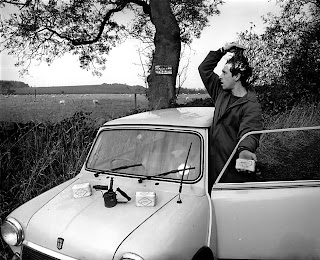About this time last year I began to smell burning first thing every morning; I put it down to toast from the flat below. I smoke, so I’m used to having something burning, right under my nose. But this was different – burnt toast is the only way to describe it. It wasn’t until I attended a ‘sleep-over’ in a museum and woke up amongst mummies (dressed like a mummy myself – you had to bring your own sleeping bag), to the all too familiar aroma of burnt bread, that I knew something was seriously amiss.
I was referred to an Ear Nose and Throat Specialist. She poked a tiny camera a long way up my nose (a kind of fiber-optic tube). My watering eyes followed her dry ones, deep inside my head, via a monitor on the desk. I was both uncomfortable and somewhat nervous. “We are on a ‘head-trip’ together – complete strangers, yet fellow travelers” I remarked. No response, she just made a few notes then after a short while slowly withdrew the camera from my nostril. I waited for some kind of diagnosis, but she seemed more interested the state of her camera. The Doctor examined the camera, turned it over in her fingers, brought it up to her eye; in fact the Doctor spent more time examining her own equipment than she had spent examining me! The whole thing was disproportionate.
“What’s all this white dust?” she said, as she continued to scrutinize the tiny implement. I reached for my glasses and said, “White dust up my nose? Here, let me look”. She was right, the Ear, Nose and Throat Specialist wasn’t seeing things, the tube was dusty – no, pasty, coated in what appeared to be a flour and water type of gluey substance. I smelled it and it was odorless. I had no explanation other than I used to sniff hell of a lot of glue. But that was years ago – when I was a teenager – we used to meet in a bandstand in the park… I spilled the beans, named names: Bostik; Uhu; Evostick; Superglue; Gorilla. Strange thing: I can’t recall the names of any of my fellow-sniffers (friends?) yet I can recall all the brands of glue I abused – as well as a fair few of my preferred felt-tipped tipples, of the time. Perhaps the names of glues just stick. Someone should research ‘Adhesives and Memory’ (Bergsonesque). She sent me for a brain scan.
I’ve got to have an operation – a problem with my sinuses – nothing serious – keep putting it off (worried about the swelling and wearing all that wadding); and it has nothing whatsoever to do with the white stuff I secreted on the camera. I only recently got to the bottom of that mystery (almost a year after my consultation), and quite by accident; the enigma was solved by another camera (my own) making an accidental exposure of my nose.
I often record these ‘pulling sessions’ with self-timer photographs. But one ritual I never forget to perform (before chinning of the bar) is the generous application of gymnastic chalk to both hands. Gymnastic chalk (light magnesium carbonate) is absolutely essential as it absorbs sweat that inevitably builds up on the palms, as well as aiding grip – adhesion.
The camera’s self-timer was still running on ‘continuous’ (taking a picture every four seconds) as I fumbled to release it from the tripod, when it made this accidental exposure of the interior of my powdered nose - of the light magnesium carbonate I must unknowingly inhale (and remember, you become heavy breather when you are pulling) at least one hundred times a day, each time my nose becomes level with my chalked fingers (yet, inhaled it is, as I never pick my nose).
This artless image has perfectly captured my chalk encrusted nasal hair, and portrayed it with all the beauty (in its own way) of those photographs you often come across; Jack Frost encrusted cobwebs in the hedgerow on a bright winter morning (a subject-matter much beloved car crash victims, as they lay dying in the ditch; a lovely 'last sight' at least - especially if the crash victim was active in a Camera Club). Also, cameras and chalk don’t mix; the Doctor was right to show concern. I’m mindful of wiping the chalk off my hands before touching my lens. And this mistake of a picture does go someway towards proving: “art is the act of making the invisible visible”.

























































